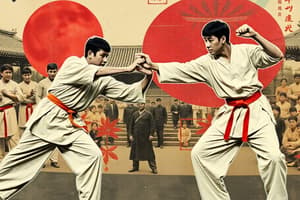Podcast
Questions and Answers
What is a key principle discussed in relation to effective fighting techniques in martial arts?
What is a key principle discussed in relation to effective fighting techniques in martial arts?
- Aerodynamics
- Momentum (correct)
- Temperature Control
- Chemical Reactions
Which of the following is NOT a biomechanical aspect covered in the discussion of martial arts?
Which of the following is NOT a biomechanical aspect covered in the discussion of martial arts?
- Energy
- Center of Mass
- Levers
- Fluid Dynamics (correct)
What type of injuries does the content suggest can be reduced through the application of physics in martial arts?
What type of injuries does the content suggest can be reduced through the application of physics in martial arts?
- Sprains
- Traumatic Brain Injuries (correct)
- Abrasions
- Fractures
Which concept helps in understanding how to utilize force effectively during a martial arts technique?
Which concept helps in understanding how to utilize force effectively during a martial arts technique?
What illusion is emphasized concerning safety equipment in martial arts?
What illusion is emphasized concerning safety equipment in martial arts?
In considering the physics of martial arts, which factor is crucial in determining the effectiveness of a strike?
In considering the physics of martial arts, which factor is crucial in determining the effectiveness of a strike?
What role do levers play in martial arts techniques according to the discussed principles?
What role do levers play in martial arts techniques according to the discussed principles?
Which of the following physiological aspects is NOT addressed in the context of martial arts?
Which of the following physiological aspects is NOT addressed in the context of martial arts?
What role does the center of mass play during martial arts training?
What role does the center of mass play during martial arts training?
How does the center of mass differ for individuals with varying muscle mass?
How does the center of mass differ for individuals with varying muscle mass?
What is a common misconception about the center of mass related to physical attributes?
What is a common misconception about the center of mass related to physical attributes?
What can martial artists use their understanding of physics for during training?
What can martial artists use their understanding of physics for during training?
What does the term 'macroscopic scope' refer to in the context of physics in martial arts?
What does the term 'macroscopic scope' refer to in the context of physics in martial arts?
What type of additional content is included in the sparring book alongside the main text?
What type of additional content is included in the sparring book alongside the main text?
Why is it suggested to read the content of the book like a skeptic?
Why is it suggested to read the content of the book like a skeptic?
What is the advised attitude towards the 'math boxes' in the book?
What is the advised attitude towards the 'math boxes' in the book?
What should individuals consult before engaging in strenuous activities described in the manual?
What should individuals consult before engaging in strenuous activities described in the manual?
What distinguishes legal self-defense from fighting?
What distinguishes legal self-defense from fighting?
Which factor is essential for individuals to understand regarding self-defense according to local laws?
Which factor is essential for individuals to understand regarding self-defense according to local laws?
What should be the source of legal advice concerning self-defense situations?
What should be the source of legal advice concerning self-defense situations?
What does the phrase 'a black belt only covers two inches of your ass' imply?
What does the phrase 'a black belt only covers two inches of your ass' imply?
What aspect of martial arts does the chapter on energy and momentum address?
What aspect of martial arts does the chapter on energy and momentum address?
Why might helmets not significantly prevent brain damage in athletes, according to the manual?
Why might helmets not significantly prevent brain damage in athletes, according to the manual?
What is one misconception regarding safety in martial arts mentioned in the content?
What is one misconception regarding safety in martial arts mentioned in the content?
Flashcards are hidden until you start studying
Study Notes
Overview of the Book
- Title: "Fight Like a Physicist: The Incredible Science Behind Martial Arts"
- Author: Jason Thalken, PhD
- Publisher: YMAA Publication Center
- Publication Year: 2015
- ISBNs: 9781594393389 (print), 9781594393396 (e-book)
- Objective: Integrate physics principles with martial arts to enhance fighting techniques.
Key Themes of the Book
- Utilize the principles of physics—like momentum, energy, and center of mass—to gain a tactical advantage in martial arts and self-defense.
- Dispel the illusion of safety provided by protective gear such as gloves and helmets.
- Provide insights into preventing traumatic brain injuries in contact sports.
Center of Mass Explained
- Location: Generally found about an inch below the belly button, crucial for balance and determining the effects of external forces.
- Impact of Weight: Contrary to common beliefs, larger breasts do not significantly alter one's center of mass, while muscle mass can affect balance notably.
- Balance Awareness: Understanding the center of mass aids in physical stability and combat effectiveness.
Important Considerations
- Legal considerations around self-defense vary by location; awareness of laws is essential to avoid legal consequences.
- The author and publisher disclaim responsibility for injuries resulting from applying the book’s content; professional training is advised.
Structure of the Book
- Sections: Divided into sections focused on internalizing basic principles and protecting oneself with knowledge.
- Chapters: Topics include energy and momentum, the physics of strikes, brain damage in athletes, and the real implications of protective equipment.
- Includes a glossary, works cited, and an index for easy reference.
Reader Engagement
- Encourages skeptical reading and practical testing of concepts.
- Provides mathematical sections, termed "Math Box," for those interested in deeper understanding but allows skipping for less mathematically inclined readers.
Conclusion and Empowerment
- Advocates for a mindset of continuous learning and understanding physics as a foundation for enhancing martial arts skills.
Studying That Suits You
Use AI to generate personalized quizzes and flashcards to suit your learning preferences.




